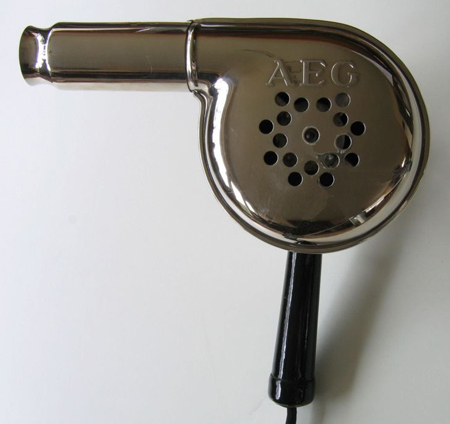A hair dryer, hairdryer or blow dryer is an electromechanical device designed to blow normal or hot air over damp hair, in order to accelerate the evaporation of water particles and dry the hair. Blow dryers allow better control over the shape and style of hair, by accelerating and controlling the formation of temporary hydrogen bonds inside each strand.
These hydrogen bonds are very powerful (allowing for stronger hair shaping than even the sulfur bonds formed by permanent waving products), but are temporary and extremely vulnerable to humidity. They disappear with a single washing of the hair. Hairstyles using blow dryers usually have volume and discipline, which can be further improved by the use of styling products and hairbrushes during drying to add tension, hold and lift.
Blow dryers were invented around the end of the 19th century. The first model was created by Alexander F. "Beau" Godefroy in his salon in France in 1890. The handheld, household hair dryer first appeared in 1920. Blow dryers are used both in beauty salons by professional stylists, and in the average household by consumers.
Function
Most hair dryers consist of electric heating coils and a fan (usually powered by a universal motor). The heating element in most dryers is a bare, coiled nichrome wire that is wrapped around mica insulators. Nichrome wire is used in heating elements because of two important properties: it is a poor conductor of electricity and it does not oxidize when heated.
In terms of modern models, a survey of stores in 2007 showed that most hair dryers have ceramic heating elements (like ceramic heaters)—because of their “instant heat” capability. This means that it takes less time for the dryers to heat up, so it takes a lot less time for the hair to dry.
Types
Today there are two major types of blow dryers (hair dryers): the handheld and the rigid-hood dryer. A hair hood dryer has a hard plastic dome that comes down and fits over a person's head in order to dry their hair. Hot air is blown out through the tiny openings around the inside of the dome so the person's hair is dried evenly. Today hair hood dryers are mainly found in hair salons.
History
In 1890 the first hairdryer was invented by French stylist, Alexander Godefroy. His invention was a large, seated version that consisted of a bonnet that attached to the chimney pipe of a gas stove. Godefoy invented it for use in his hair salon in France and it was not portable or handheld, but instead could only be used by having the person sit underneath it.
Armenian American inventor Gabriel Kazanjian was the first to patent a blow dryer in the United States, in 1911.
Around 1915, hair dryers began to go on the market in handheld form. This was due to innovations by National Stamping and Electricworks under the white cross brand,[10] and later U.S. Racine Universal Motor Company and the Hamilton Beach Co., which allowed the dryer to be small enough to be held by hand. Even in the 1920s, the new dryers were often heavy, weighing in at approximately 2 pounds (0.91 kg), and were difficult to use. They also had many instances of overheating and electrocution. Hair dryers were only capable of using 100 watts, which increased the amount of time needed to dry hair (the average dryer today can use up to 2000 watts of heat).
Since the 1920s, development of the hair dryer has mainly focused on improving the wattage and superficial exterior and material changes. In fact, the mechanism of the dryer has not had any significant changes since its inception. One of the more important changes for the hair dryer is to be made of plastic, so that it is more lightweight. This really caught on in the 1960s with the introduction of better electrical motors and the improvement of plastics. Another important change happened in 1954 when GEC changed the design of the dryer to move the motor inside the casing.
In the 1970s, the U.S. Consumer Product Safety Commission set up guidelines in the 1970s that hair dryers had to meet in order to be considered safe to manufacture. Since 1991 the CPSC has mandated that all dryers must use a ground fault circuit interrupter so that it cannot electrocute a person if it gets wet. By 2000, deaths by blowdryers had dropped to fewer than four people a year, a stark difference to the hundreds of cases of electrocution accidents during the mid-twentieth century.
Who were some of the Greatest Thinkers and Great Minds?
- Marie Curie
- Pablo Picasso
- Edwin Hubble
- Jean Piaget
- Robert Boyle
- Plato
- Rene Descartes
- Miguel de Cervantes
- Friedrich Nietzsche
- Michelangelo Buonarroti
- Gary Kasparov
- Galileo Galilei
- Dmitri Mendeleev
- Archimedes
- Albert Einstein
- Isaac Newton
- Leonhard Euler
- Enrico Fermi
- Joseph Louis Lagrange
- Carl Friedrich Gauss
- Bernhardt Riemann
- Kurt Gödel
- William Shakespeare
- Betrand Russell
- Charles Darwin
- Fyodor Dostoevsky
- Leo Tolstoy
- Niels Bohr
- Linus Pauling
- Leonardo Da Vinci
- Blaise Pascal
- Michael Faraday
- James Clerk Maxwell
- Aristotle
- Alan Turing
- Sigmund Freud
- Gottfried Leibniz
- Max Planck
- Aleksandr Pushkin
- Ivan Pavlov
- Pierre de Fermat
- Johann Wolfgang von Goethe
- Steven Hawking
- Steve Jobs

